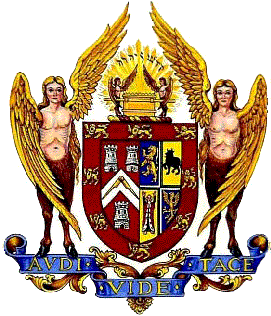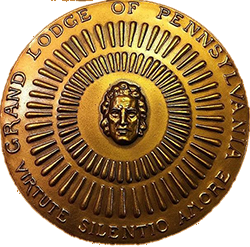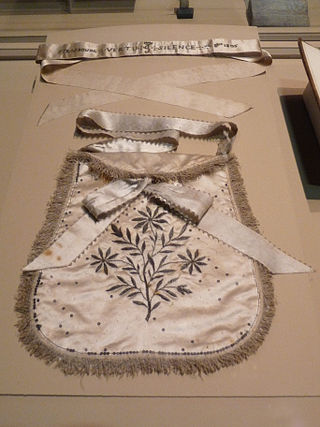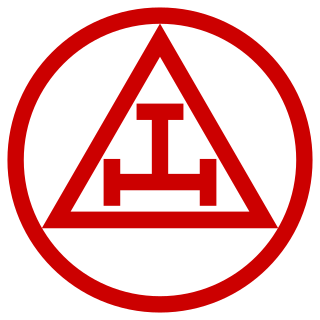Social and cultural roles
Historian Mark Carnes argues that the Freemasons, along with other fraternal societies including the Odd Fellows, the Improved Order of Red Men, and the Knights of Pythias, helped redefine traditional masculinity through new secret rituals. Soon lodges designed initiation ceremonies featuring chains, skeletons, robes, masks, blindfolds, and torch lights. This came in response to mainstream Protestant denominations which were innovating with liberal and feminized themes that devalued traditional masculinity. The result was a private set of attitudes and secret rituals that comprised an alternative counterculture. [14] A leading California Mason had a vision of Freemasonry that rejected "Dreaminess and Nambi-Pambyism," as well as "sloppy sentimentalism" or "a lady's sewing circle" or a "church pink tea." But rather a sought, "A Real Man's Organization." [15]
Although women were not members, they were wives, and their support was helpful to the rapid recovery after the 1830s. Sarah Josepha Hale in 1823, with the financial support of her late husband's lodge, published a collection of her poems titled The Genius of Oblivion. The Masonic movement continued their support for Hale's promotion of traditional ladylike roles throughout her career, especially when she served as editor for forty years of the nation's most influential women's magazine, Godey's Lady's Book," . [16]
Anti-Masonic Party
The Anti-Masonic Party was a single-issue party in the late 1820s that strongly opposed Freemasonry, but later aspired to become a major party by expanding its platform to take positions on other issues. The party was founded following the disappearance of William Morgan, a former Mason who had become a prominent critic of the Masonic organization. Many believed that Masons had murdered Morgan for speaking out against Masonry and subsequently many evangelical churches condemned Masonry. As many Masons were prominent businessmen and politicians, and often were Episcopalians with no taste for revivalism, the backlash against the Masons was also a form of anti-elitism. The Anti-Masons saw conspiracy and argued that secretive, powerful Masons posed a threat to American republicanism by plotting to control the government. Furthermore, they warned that Masonry was hostile to evangelical Christianity. Fear of politicized Masonry soon coalesced into the Anti-Masonic Party. In New York, the Anti-Masons supplanted the National Republicans as the primary opposition to the Democrats. Historians identify a hysteria that was rarely linked to facts. The Masons were bitterly opposed to Morgan but they avoided state and national politics. They saw their role as facilitating the cooperation of political leaders of differing views and parties, so it would be fatal to endorse one party. Bullock argues that Masons facilitated political cooperation by, "creating channels of communication and cooperation that eased the difficulties of organizing politics on a new scale in a political culture where challenges to elites provided a central theme." [17] Historians agree that often Masons were locally prominent, and perhaps did attempt a local cover-up of the Morgan case. But they find the main conspiracy argument exaggerated and bordering on paranoia, [18] Membership had been growing rapidly; now it plunged even faster. Of the 450 lodges in 1825, only 50 remained in 1834. [19]
As the 1830s progressed, most Antis switched to the new Whig Party, which united all voters opposed to President Jackson. Jackson was a Mason, but so too was his leading opponent Henry Clay. The Anti-Masons brought to the Whigs an intense distrust of politicians and a rejection of automatic party loyalty, together with innovative campaign techniques to whip up excitement among the voters. They invented the national convention in 1835. [20] By 1840, the Antis had ceased to function as a national organization and local cells had disappeared. Those few Antis to become leading politicians, such as William H. Seward, Thurlow Weed and Thaddeus Stevens, became leaders of the Whig Party and Republican parties, and downplayed their early opposition to Freemasonry.
International affairs
In addition to friendly relations with Masonic bodies in other countries, the Masonic movement provided a mechanism for international cooperation among national leaders and men of affairs. According to Joachim Berger, from the late 19th century Masonic lodges spearheaded efforts to form permanent links between nations. They played an especially active role in 1914-1919, as the leaders that fought against Germany worked hard to promote public opinion favorable to longstanding rivals who were now military allies. Leaders in London and Paris were especially active in building support for the Allies in the United States. By 1918 the goal was gaining support for the new League of Nations, with New York Masons especially active. Political discussions were not allowed during lodge meetings--but the Masonic networks brought together like-minded men who cooperated in promoting internationalism. [21]

Freemasonry or Masonry refers to fraternal organisations guilds of stonemasons that, from the end of the 14th century, regulated the qualifications of stonemasons and their interaction with authorities and clients. Modern Freemasonry broadly consists of two main recognition groups: Regular Freemasonry, which insists that a volume of scripture be open in a working lodge, that every member professes belief in a Supreme Being, that no women be admitted, and that the discussion of religion and politics do not take place within the lodge; and Continental Freemasonry, which consists of the jurisdictions that have removed some, or all, of these restrictions.
The Anti-Masonic Party was the earliest third party in the United States. Formally a single-issue party, it strongly opposed Freemasonry in the United States. It was active from the late 1820s, especially in the Northeast, and later attempted to become a major party by expanding its platform to take positions on other issues. It declined quickly after 1832 as most members joined the new Whig Party; it disappeared after 1838.

A Masonic lodge, often termed a private lodge or constituent lodge, is the basic organisational unit of Freemasonry. It is also commonly used as a term for a building in which such a unit meets. Every new lodge must be warranted or chartered by a Grand Lodge, but is subject to its direction only in enforcing the published constitution of the jurisdiction. By exception the three surviving lodges that formed the world's first known grand lodge in London have the unique privilege to operate as time immemorial, i.e., without such warrant; only one other lodge operates without a warrant – the Grand Stewards' Lodge in London, although it is not also entitled to the "time immemorial" title. A Freemason is generally entitled to visit any lodge in any jurisdiction in amity with his own. In some jurisdictions this privilege is restricted to Master Masons. He is first usually required to check, and certify, the regularity of the relationship of the Lodge – and be able to satisfy that Lodge of his regularity of membership. Freemasons gather together as a Lodge to work the three basic Degrees of Entered Apprentice, Fellowcraft, and Master Mason.
The history of Freemasonry encompasses the origins, evolution and defining events of the fraternal organisation known as Freemasonry. It covers three phases. Firstly, the emergence of organised lodges of operative masons during the Middle Ages, then the admission of lay members as "accepted" or "speculative" masons, and finally the evolution of purely speculative lodges, and the emergence of Grand Lodges to govern them. The watershed in this process is generally taken to be the formation of the first Grand Lodge in London in 1717. The two difficulties facing historians are the paucity of written material, even down to the 19th century, and the misinformation generated by masons and non-masons alike from the earliest years.

The United Grand Lodge of England (UGLE) is the governing Masonic lodge for the majority of freemasons in England, Wales, and the Commonwealth of Nations. Claiming descent from the Masonic Grand Lodge formed 24 June 1717 at the Goose & Gridiron Tavern in London, it is considered to be the oldest Masonic Grand Lodge in the world, together with the Grand Lodge of Scotland, and the Grand Lodge of Ireland.
Prince Hall Freemasonry is a branch of North American Freemasonry for African Americans founded by Prince Hall on September 29, 1784. There are two main branches of Prince Hall Freemasonry: the independent State Prince Hall Grand Lodges, most of which are recognized by State grand lodges, and those under the jurisdiction of the National Grand Lodge. Prince Hall Freemasonry is the oldest and largest predominantly African-American fraternity in the United States.

The Grand Lodge of Ireland is the second most senior Grand Lodge of Freemasons in the world, and the oldest in continuous existence. Since no specific record of its foundation exists, 1725 is the year celebrated in Grand Lodge anniversaries, as the oldest reference to Grand Lodge of Ireland comes from the Dublin Weekly Journal of 26 June 1725. This describes a meeting of the Grand Lodge to install the new Grand Master, The 1st Earl of Rosse, on 24 June. The Grand Lodge has regular Masonic jurisdiction over 13 Provincial Grand Lodges covering all the Freemasons of the island of Ireland, and another 11 provinces worldwide.
Anti-Masonry is "avowed opposition to Freemasonry", which has led to multiple forms of religious discrimination, violent persecution, and suppression in some countries as well as in various organized religions. However, there is no homogeneous anti-Masonic movement. Anti-Masonry consists of radically differing criticisms from frequently incompatible political institutions and organized religions that oppose each other, and are hostile to Freemasonry in some form.

The Order of Mark Master Masons is an appendant order of Freemasonry that exists in some Masonic jurisdictions, and confers the degrees of Mark Mason and Mark Master.

The Grand Lodge of Pennsylvania, officially The Right Worshipful Grand Lodge of the Most Ancient and Honorable Fraternity of Free and Accepted Masons of Pennsylvania and Masonic Jurisdictions Thereunto Belonging, sometimes referred to as Freemasons of Pennsylvania is the premier masonic organization in the Commonwealth of Pennsylvania. The Grand Lodge claims to be the oldest in the United States, and the third oldest in the world after England and Ireland, having been originally established as the Provincial Grand Lodge of Pennsylvania in 1731. This claim is disputed by both the Grand Lodge of Massachusetts and the Grand Lodge of Virginia.

Freemasonry has had a complex relationship with women for centuries. A few women were involved in Freemasonry before the 18th century, despite de jure prohibitions in the Premier Grand Lodge of England.

The Book of Constitutions of this Grand Lodge or Ahiman Rezon was a constitution written by Laurence Dermott for the Ancient Grand Lodge of England which was formed in 1751. The formation of the Ancient Grand Lodge brought together lodges and Masons who, believing themselves to be part of an older, original Masonic tradition, had chosen not to ally themselves with the previously formed Moderns Grand Lodge of 1717.

The Ancient Grand Lodge of England, as it is known today, or The Grand Lodge of the Most Ancient and Honourable Fraternity of Free and Accepted Masons as they described themselves on their warrants, was a rival Grand Lodge to the Premier Grand Lodge of England. It existed from 1751 until 1813 when the United Grand Lodge of England was created from the two Grand Lodges. They are now called the Antients, in contrast to the Moderns, the original Grand Lodge which its critics, notably Laurence Dermott, said had moved away from the ritual of Scotland, Ireland, and now the Antient Grand Lodge. This Grand Lodge was also informally called the Atholl Grand Lodge because the Third and Fourth Dukes of Atholl presided over it as Grand Masters for half of its 62-year existence.

The organisation now known as the Premier Grand Lodge of England was founded on 24 June 1717 as the Grand Lodge of London and Westminster. Originally concerned with the practice of Freemasonry in London and Westminster, it soon became known as the Grand Lodge of England. Because it was the first Masonic Grand Lodge to be created, modern convention now calls it the Premier Grand Lodge of England in order to distinguish it from the Most Ancient and Honourable Society of Free and Accepted Masons according to the Old Constitutions, usually referred to as the Ancient Grand Lodge of England, and the Grand Lodge of All England Meeting at York. It existed until 1813, when it united with the Ancient Grand Lodge of England to create the United Grand Lodge of England.

This is a chronology of the formation of "regular" or "mainstream" Masonic Grand Lodges in North America, descending from the Premier Grand Lodge of England or its rival, the Antient Grand Lodge of England. A Grand Lodge is the governing body that supervises "Craft" Freemasonry in a particular jurisdiction or geographical area.

The Royal Arch is a degree of Freemasonry. The Royal Arch is present in all main masonic systems, though in some it is worked as part of Craft ('mainstream') Freemasonry, and in others in an appendant ('additional') order. Royal Arch Masons meet as a Chapter; in the Supreme Order of the Royal Arch as practised in the British Isles, much of Europe and the Commonwealth, Chapters confer the single degree of Royal Arch Mason.
Continental Freemasonry, otherwise known as Liberal Freemasonry, Latin Freemasonry, and Adogmatic Freemasonry, includes the Masonic lodges, primarily on the European continent, that recognize the Grand Orient de France (GOdF) or belong to CLIPSAS, SIMPA, TRACIA **, CIMAS, COMAM, CATENA, GLUA, or any of various other international organizations of Liberal, i.e., Continental Freemasonry. The larger number of Freemasons, most of whom live in the United States–where Regular Freemasonry holds a virtual monopoly–belong to Masonic lodges that recognize the United Grand Lodge of England and do not recognize Continental Freemasons, regarding them as "irregular".

Royal Arch Masonry is the first part of the American York Rite system of Masonic degrees. Royal Arch Masons meet as a Chapter, and the Royal Arch Chapter confers four degrees: Mark Master Mason, Past Master, Most Excellent Master, and Royal Arch Mason.

Masonic ritual is the scripted words and actions that are spoken or performed during the degree work in a Masonic lodge. Masonic symbolism is that which is used to illustrate the principles which Freemasonry espouses. Masonic ritual has appeared in a number of contexts within literature including in "The Man Who Would Be King", by Rudyard Kipling, and War and Peace, by Leo Tolstoy.
Freemasonry in Spain is first recorded in 1728, in an English lodge. As various papal bulls condemned Freemasonry the Spanish Inquisition did their best to close lodges and demonise Freemasons, therefore the success of Freemasonry from year to year depended on the sympathy or antipathy of the ruling regime. Nevertheless, lodges and even Grand Lodges were formed, and even thrived during more liberal periods. When Francisco Franco consolidated power in 1939, all Freemasonry was banned. In 1979, four years after Franco's death, bans on Freemasonry were declared unconstitutional, and several Grand Lodges and Orients now flourish in Spain.















